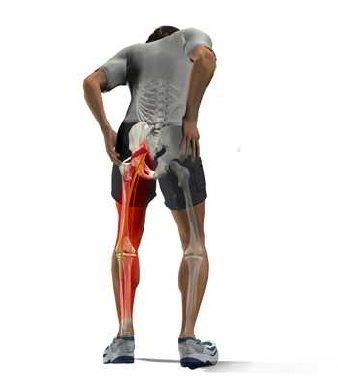The piriformis syndrome is a condition in which the piriformis muscle irritates the sciatic nerve, causing pain in the buttocks and referring pain along the course of the sciatic nerve. This referred pain, called “sciatica”, often goes down the back of the thigh and/or into the lower back. Piriformis syndrome is six times more likely to occur in women than men. At Georgia Clinic of Chiropractic (Augusta, GA) we treat regularly patients suffering from piriformis syndrome, many of whom became injured due to a variety of sports or athletic activities.

- The piriformis muscle is one of the small muscles deep in the buttocks that rotates the leg outwards.
- It runs from the base of the spine (the sacrum) and attaches to the thigh bone (femur) roughly where the outside crease in your bum is.
- The sciatic nerve runs very close to this muscle and in some people (around 10% of the population) it passes straight through the muscles’ fibers!
- If the piriformis muscle becomes tight it can put pressure on the sciatic nerve and cause pain which can radiate down the leg, commonly known as sciatic pain.
- It has been suggested that this condition would be better referred to as piriformis impingement due to the impingement of the sciatic nerve.
- A common cause of Piriformis syndrome is having tight adductor muscles (inside your thigh). This means the abductors on the outside cannot work properly and so put more strain on the Piriformis.
Symptoms of Piriformis Syndrome
- Tenderness in the area of the muscle.
- Pain in the buttocks.
- Pain which radiates down the back of the leg, usually into the hamstrings and sometimes even the calf muscles.
- It is common for pain to initially be confused with a hamstring strain or hamstring origin tendinopathy. However there will be no area in the hamstrings which is tender to touch.
- Reduced range of motion of the hip joint, especially into internal hip rotation.
Causes and Treatment for Piriformis Syndrome
Short, tight muscles can come about from few different situations—lack of stretching, weak synergistic or antagonistic muscles, chronic subluxation, and foot dysfunction. Every one of these scenarios is reversible; therefore piriformis syndrome is a correctable disorder. With chiropractic, you are addressing the problem itself–the short, tight muscles, versus taking prescription medications to cover up the pain. We provide targeted treatments at Georgia Clinic of Chiropractic, so that a patient suffering from piriformis syndrome would be treated specifically for their piriformis muscle, while a patient suffering from IT Band Syndrome would specifically be treated for their iliotibial band. The hallmark of our care is providing specific, targeted and goal-oriented treatments for each and every patient.
The Georgia Clinic of Chiropractic Blog is written by Dr. Mark Huntsman.
Georgia Clinic of Chiropractic is conveniently located off Furys Ferry Rd in Martinez, Georgia and provides quality chiropractic care to the Augusta, Martinez, and Evans communities. Visit our main website at www.georgia-clinic.com.
Choose several options to schedule your appointment: call (706) 814-5053, use our online voicemail, or use our online form.
